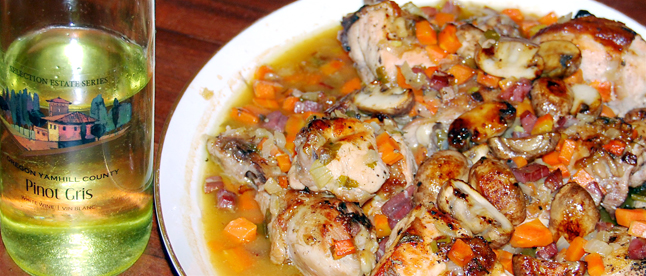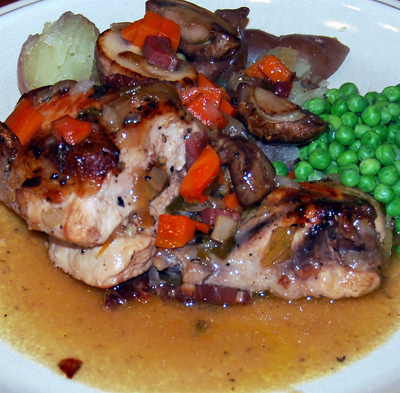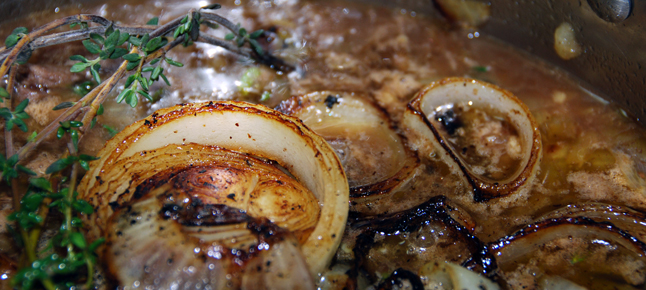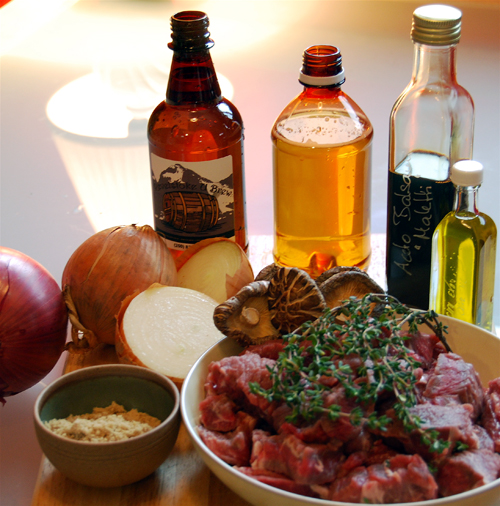Notes on Cooking with Wine and Beer
One-Pan Coq au Vin
Beef in Beer (Carbonnades à la flammande)
Cooking with wine and beer has been traditional in many societies for at least 5000 years. Before refrigeration, fermenting grape and barley was one way to preserve fruit and grain otherwise subject to rot, and marinating meat in alcohol helped make it last longer. French, Italian and Greek cooking use wine, whereas the nordic nations have preferred beer.
Cooking with wine can sound like an expensive proposition when the least expensive liquor store wine available in BC comes in at $9 per bottle. However, if a bottle of wine eliminates the need for tomato ketchup, HP Sauce or more expensive jellies and condiments, then half a bottle of wine is a bargain.
One solution for economics in cooking with wine or beer is to make your own. Revelstoke U-Brew makes wine that comes in at as low as $6 a bottle. Joel and Kristi and their brewmaster Larry Olsen make excellent wine and excellent beer for half the cost of commercial products.
Don’t worry about the kids getting drunk—no alcohol will touch their lips. During the cooking process, the alcohol evaporates. Ethanol, the alcohol in drinks, has a boiling point of 78.3 degrees Centigrade, or 172 Fahrenheit. When you bake something at 350F, or boil it on the stove so that bubbles form, the booze turns to gas and floats away in the air, leaving behind the juices and flavours.
For cooking, stick to wines you would enjoy drinking. So-called “cooking wines” are full of salt, preservative and food colouring, and are not intended for the table. I don’t think it’s useful or economic to use a really fine wine to cook with, but in general, as with wine to drink, the better the wine, the better the food.
Both the following recipes are great for a crowd, but if you double or triple the recipe, do the same with the number of pans and pots. The beef can be prepared the day before you serve it. My one-pan for the coq au vin is from Chantilly Kitchen, Bed and Bath on MacKenzie—it’s my new ceramic frypan and I cannot stop singing its praises.
One-Pan Coq au Vin

Traditional recipes for Coq au Vin require separate treatment for onions, mushrooms, chicken browning, braising in wine, with a different pan for each. I’ve simplified things with one big skillet that can go into the oven. It should be shallow and wide enough that each piece of chicken can sit in the wine underneath but have it’s top exposed to the hot oven air—think suntanning with your bum in the sea. I use my new 12-inch ceramic-coated non-stick frypan—it goes into the oven after you brown the chicken on the stove, and can do the browning fast as it takes very high temperatures. A stainless steel or cast iron pan is equally good but a lot harder to clean. I made this with white wine; red is fine, especially for chicken legs and thighs. Julia Child’s Coq au Vin calls for the bacon to be desalted in boiling water, but I’m not sure this is necessary.

Preheat the oven to 350° F.
1 whole 2-kilo chicken, cut into pieces, or 2 kilos of chicken pieces
200 grams pancetta, or 4 slices of bacon, diced small
1 large onion
2 carrots
2 cups white wine
½ lb tight mushrooms, quartered if large or whole if tiny
2 tbsp olive oil
2 tbsp butter
Salt and pepper to taste
In a wide ovenproof pan, brown the pancetta or bacon in 1 tbsp of the olive oil. Dice the onion and carrot and put these into the pan. Brown for 10 minutes, and remove from the pan to a bowl.
Melt 1 tbsp of the butter and the remaining 1 tbsp of the olive oil in the pan, and add the chicken pieces. Brown for 5 to 10 minutes on each side, until the skin is crispy. Turn off the heat, and scatter the browned pancetta, onion and carrot over the chicken. Pour in the 2 cups of wine, and grind fresh pepper over the top. There should be enough liquid to cover the chicken pieces half way, leaving the upper sides uncovered. Put the pan into the oven and braise the chicken for 40 minutes.
When the chicken is cooked, spoon the chicken pieces, vegetables and broth into a wide, shallow serving dish, being careful to handle the pan with oven mitts. Leave 1 tbsp of the broth in the pan, and add 1 tbsp of butter. Sauté the mushrooms in the butter and broth for about 5 minutes at high heat, until the mushrooms are brown and crispy. Spoon them over the chicken pieces, spoon some of the juices over everything, and serve.
The traditional accompaniments to coq au vin are potatoes and green peas. I used small yellow spuds and smashed them after boiling for 20 minutes (Smashed Potatoes: boil potatoes without peeling, drain, return to pot, add 1 tbsp butter, give them just one mash all over with the potato masher so the skins are broken and each spud is crushed, but they are still recognizably potatoes. Add butter and salt and pepper to taste.) I like the frozen green peas called Petit Pois on the package.
Note on chicken choice: I used an organic whole chicken. These are available frozen in Revelstoke at Coopers, Natural Foods and PT Market. Mountain Meals also sells chickens. This means you have to thaw then cut up the chicken yourself, not an onerous job but one that takes five minutes, a heavy sharp knife, and a common sense understanding of chicken anatomy. You think you can’t cut through the breastbone but with a good knife you can; however, you must find the joints to remove the legs and wings. If you use pre-cut-up chicken legs, breasts, or thighs, leave the skin on as its fat adds flavour. If you use the frozen packaged chicken, read the labels and consider that the sodium (salt) content of one chicken breast in the frozen packs is anywhere from 380 to 690 grams (depends on brand and package size)—the recommended adult salt intake is 1500 mg daily. See this link for salt info: http://www.hc-sc.gc.ca/hl-vs/iyh-vsv/food-aliment/sodium-eng.php. Commercially frozen hatchery chicken is “pumped” (injected) with water and sodium to up the weight and plump the look.
Beef in Beer

This is the traditional Carbonnades à la flammande, a Belgian traditional dish. Belgium was once the beer-drinking nation of the world, but has been displaced in this regard by the Czech Republic. Canada is no. 19 on the list of beer consumption per capita. I made this with Honey Blond Ale from Revelstoke U-Brew; I also tried it using a brand name pale ale—the result was a dish with altogether less flavour. Next time, I’ll try it with U-Brew’s Munich Dark Lager, just to see the difference. (If you have some and try it, let me know what it’s like.) Some recipes for Carbonnades call for flour in which to brown the meat, but when I tried this, we found the gravy a little gluey, so the following version omits the flour.
The dish is rich and sumptuous, given the simplicity of the ingredients, and fills the house with an absolutely mouth-watering aroma. You will

want to eat it immediately, but it’s actually better the next day, reheated for 30 minutes in a 350° oven, so it’s perfect for après-ski (or après-skidoo.) Traditional accompaniment is broad noodles, but I prefer rice or quinoa to soak up the gravy.
Serve with a good pale ale or lager, and a simple green salad. Apple tart is the traditional dessert: use the Company Apple Pie from last week, but make it a little lighter by omitting the top crust and serving with sour cream. Make your own by putting ¼ cup of buttermilk into whipping cream and letting this stand in the fridge for 12 hours.
The beef: I used braising steak, which at over two pounds for just over $8.00 was certainly the most economical meal I’ve cooked in a while. This is enough for six people —the gravy is so rich that it goes a long way, although four younger healthy male appetites might demolish the lot. You cut the meat into pieces, and I cut out the larger fat bits, but you want the meat well marbled for flavour. The left-overs taste great, though, so don’t worry about making too much.
2 to 2 ½ lbs. braising steak
2 lbs onions, ( 6 medium or 5 large), half chopped and half sliced
1/3 cup olive oil*
6 cloves garlic, finely chopped
3 tbsp. brown sugar
2 tbsp. balsamic vinegar*
1 tsp salt
3-5 stems fresh thyme, on the branch
2 bay leaves
¼ cup finely chopped parsley
1 cup beef broth
2 cups Honey Blond Ale
freshly ground pepper to taste.
* I used Porcini Olive Oil and Maletti Balsamic from Crescendo. These are so flavourful it’s worth obtaining some for this recipe. Otherwise, use virgin olive oil and regular balsamic, or 4 tbsp. regular red wine vinegar.
Pre-heat the oven to 350° F.
In an ovenproof casserole that also goes onto the stove, brown the onions in half the olive oil. When they are nicely brown, remove to a bowl.
While onions are browning, cut the steak into pieces about 1 X 2 inches, removing some of the larger pieces of fat and any gristle. Put the rest of the olive oil into the pan, and brown the meat until at least two sides show a little brown, or seem sealed. The meat will release juices into the pan, so if you have time, do this in two batches. The point is to seal the juices in, not release them, so you want a hot fire.
When meat is browned, return the onions to the pan and add the garlic, brown sugar, balsamic vinegar, beef broth, beer, thyme, parsley, bay leaves, salt and pepper. Stir.
Bake uncovered for two hours, or until the meat is as tender as you want it.
Ovens vary, so check the liquid level every so often. The beef should remain covered. Add more beer if necessary.
Dumplings are traditional with carbonnades, but I prefer a homemade baguette. If you want to do a veg with this other than green salad, cole slaw, sauerkraut salad or braised red cabbage with apples would work well. I did quinoa pilaf with green peas and mushrooms that was nice too.



